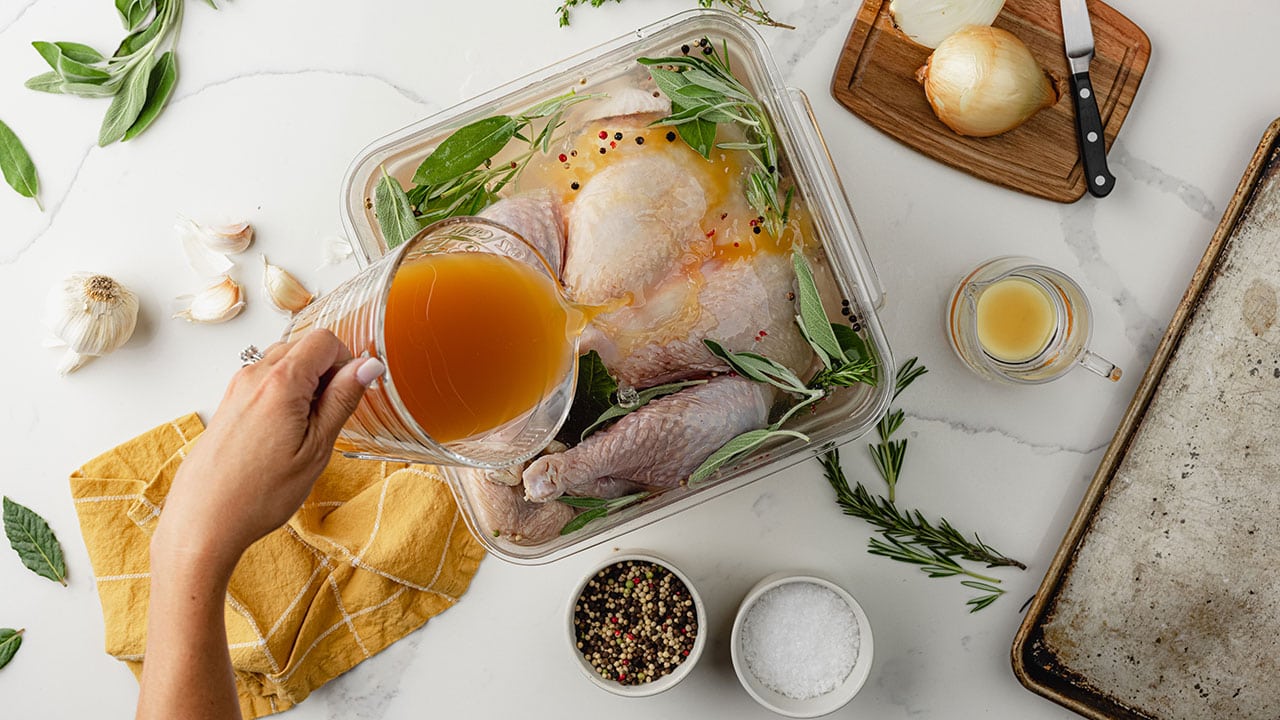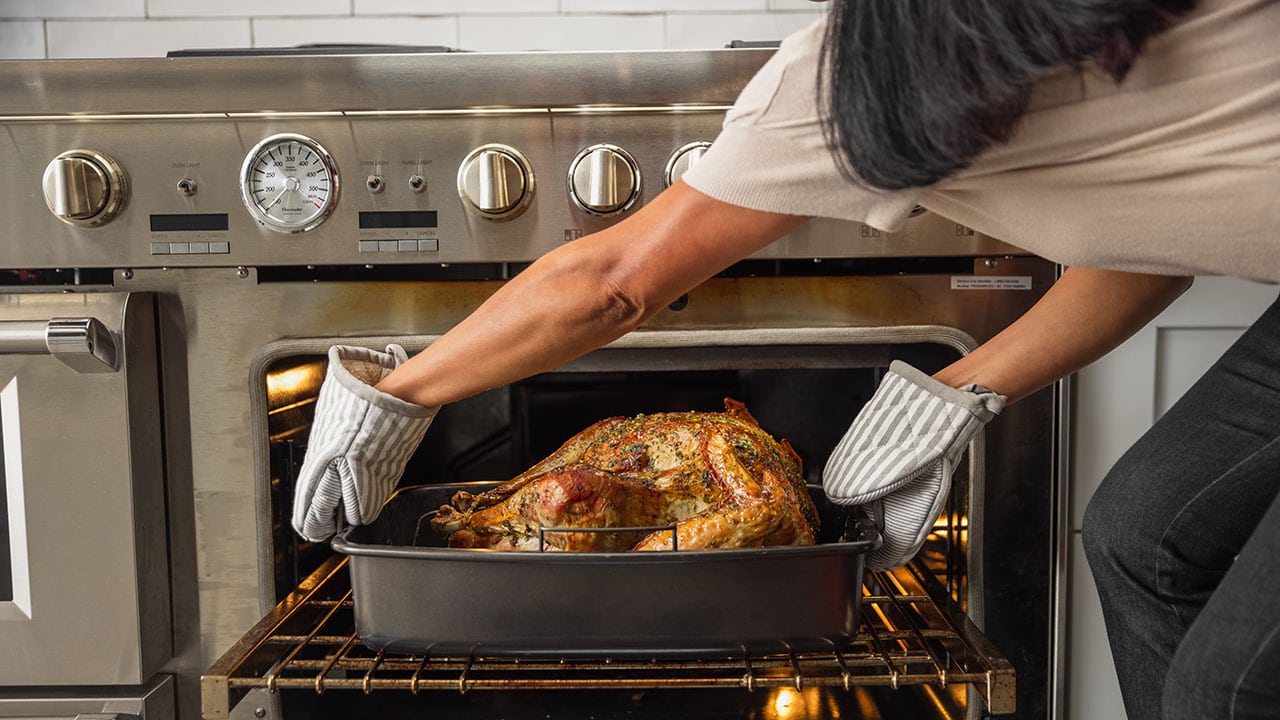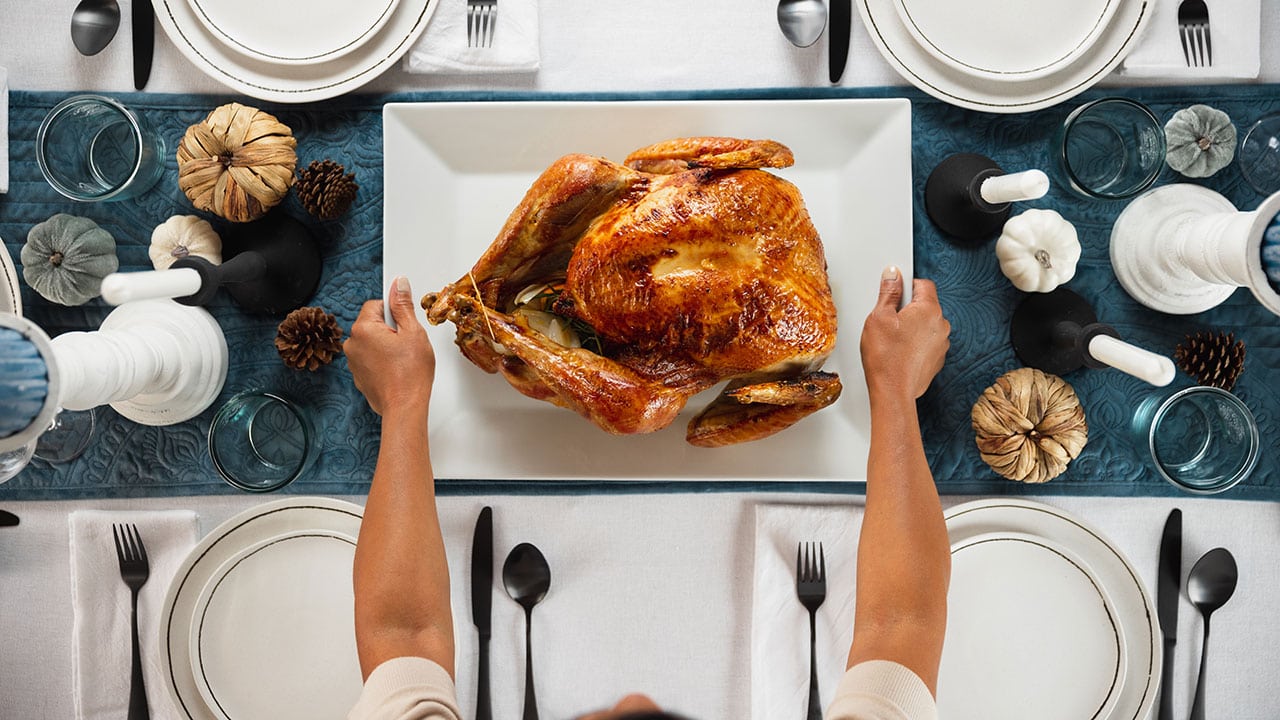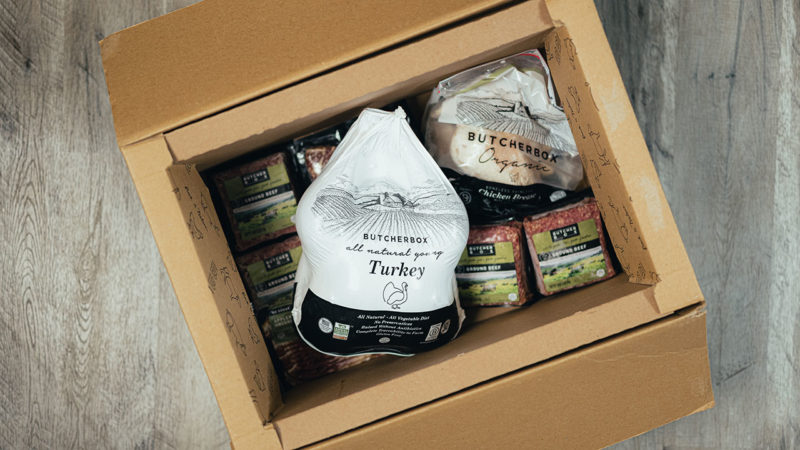Last Updated on November 21, 2023
When you choose ButcherBox, you’re getting more than an amazing turkey delivered right to your door. You’re tapping into a community that wants to make your cooking experience easier, especially when it comes to whipping up Thanksgiving dishes. So, here’s our guide to do just that.
We’ll dive deeper into each section, but this is how you’ll turn your frozen turkey into a delicious centerpiece:
- Choose a thawing method
- Prep with a brine, rub, and/or stuffing
- Cook in the oven (or another method)
- Know when your bird is done
- Carve and serve to family and friends
Ready for a stress-free holiday celebration and a mouthwatering meal? Let’s get started!
How to Thaw a Frozen Turkey

Since ButcherBox’s turkey comes frozen, you’ll need to thaw it before you do anything else.
Keep in mind that the thawing process typically requires several days as well as lots of space in your freezer and refrigerator. For every four to five pounds of turkey, you’ll want to factor in one day of thawing, so if you have a 12-pound turkey, it’ll need to thaw for three days. (There are also ways to thaw in shorter time periods, which we’ll dig into below). Take a look at the chart below to find your bird’s weight and thaw time.
| Turkey Weight | Thaw Times |
| 4–12 lbs | 1–3 days |
| 12–16 lbs | 3–4 days |
| 16–20 lbs | 4–5 days |
| 20–24 lbs | 5–6 days |
For the best results, you’ll want to use one of the following methods: Refrigerator thawing or cold-water thawing. While cold water thawing is quicker and great if you have space or time constraints, we recommend using your refrigerator as it’s an easier process.
Refrigerator Thawing
- Place turkey breast-side up on a tray and allow it to thaw in the fridge (40°F or below) for the recommended time (see thawing chart above). Do not remove the wrapper.
- Prepare your turkey within 1–2 days after thawing.
Cold Water Thawing
- Place turkey breast-side down in a large container and cover with cold water. Do not remove the wrapping.
- Change the water every 30 minutes, and if the turkey is not completely submerged in the water, rotate it now, too, to make sure it stays cold.
- Continue this process as needed. You can estimate thawing time by factoring in 30 minutes for every pound of turkey.
- Prepare your turkey immediately after thawing.
How to Prep a Turkey

Once your turkey is thawed, you’ll want to get it ready for your preferred cooking method. Here are a few common techniques you can use. Just be sure to give yourself plenty of time to prep—you don’t want to miss out on incredible flavor!
Brine
This technique uses a solution of salt and water to tenderize the meat and add flavor. Typically, you’ll soak your turkey overnight. You can also customize the basic recipe by substituting the water for another liquid and adding in your favorite seasonings.
- Recommended time: 12–18 hours (about 1 hour per pound of turkey)
- Simple recipe: 2 cups salt and 2 gallons water
- Recipe to try: Apple Cider Brine
Rub
Also known as a dry rub, this technique calls for spreading a mixture of herbs and spices over meat to infuse flavors into it a few hours before cooking. You can also add a small amount of liquid to get a paste-like mixture or incorporate sugar to encourage caramelization.
- Recommended time: 12–24 hours
- Simple recipe: 1 tablespoon salt, 1 teaspoon black pepper, 2 tablespoons favorite spices (e.g. sage, rosemary)
- Recipe to try: BB Seasoned Salt
Stuffing
A common practice, stuffing (or dressing) your turkey involves filling your bird with a mixture of starch, vegetables, liquid, and seasonings. Cubed bread or breadcrumbs and broth are usually the go-to ingredients for most families, but you can also use rice or potatoes and water or alcohol to flavor your stuffing. If you plan on stuffing your turkey, keep in mind that it could affect cooking times. Make sure the innermost part of the stuffing reaches 165°F before you stop cooking the turkey.
- Recommended time: 0 hours—once stuffed, you can cook your turkey right away
- Simple recipe: 8 cups cubed bread, 2½ cups vegetables, ½ cup broth, 1 cup butter or oil, seasonings
- Recipe to try: Simple Turkey Stuffing
Ways to Cook a Turkey
 No matter which cooking method you use, cooking times can vary and pop-up timers can be unreliable. There’s only one way to be sure your turkey is done: the temperature. Your turkey will be done when its internal temperature in the thigh, breast, and stuffing (if applicable) reaches 165°F as measured by a food thermometer.
No matter which cooking method you use, cooking times can vary and pop-up timers can be unreliable. There’s only one way to be sure your turkey is done: the temperature. Your turkey will be done when its internal temperature in the thigh, breast, and stuffing (if applicable) reaches 165°F as measured by a food thermometer.
This is especially true for your turkey since it contains 55% less fat than other birds, as determined by the USDA. Because it’s a leaner bird, you’ll want to keep a close eye on it to avoid overcooking.
How to Roast a Turkey
Roasting a turkey is fairly straightforward, which makes it a great technique to use whether this is your first time hosting Thanksgiving or you’re a pro. You can follow our standard instructions below or try our favorite traditional turkey recipe.
- Preheat oven to 450°F. If using a brine, discard it. Pat the turkey dry with a cloth or paper towel (this will help you achieve crispy skin).
- Place the turkey breast-side-up onto a flat rack in a shallow roasting pan and fill the roasting pan with chicken stock.
- Tuck the wings back to keep the turkey in place (and to help with carving later). Brush the turkey lightly with oil.
- Cook in the oven for 20 minutes. Lower the temperature to 325°F and cover the turkey loosely with an aluminum foil tent to prevent overcooking.
- Roast for approximately 13-15 minutes per pound. Roughly 1 hour before the turkey is scheduled to be done, remove the foil tend to allow turkey to brown.
- Your turkey will be done when its internal temperature in the thigh, breast, and stuffing (if applicable) reaches 165°F as measured by a food thermometer. It is very important not to over roast! Our birds have less fat; therefore, they cook in less time than most other birds. Place the turkey on a platter and let it rest for at least 30 minutes before carving.
Other Methods to Consider
If you’re looking to do something a little different this year, there are plenty of alternative cooking options to choose from. Here are some of our favorites:
- Grill: This is a great twist on the traditional dinner. Use a roasting pan to collect drippings for an irresistible gravy and be sure to leave the stuffing on the side to make sure your bird is perfectly cooked.
- Smoke: The beauty behind smoking your turkey is that you don’t need a ton of ingredients to get a tasty turkey. Most of the flavor comes from the wood chips, which give the turkey a richness and smokiness guests will love.
- Deep-Fry: This method gets a lot of flak, but it’s a great one if you’re strapped for oven space and looking for extra crispy turkey skin. Just come prepared with heavy-duty oven mitts and a fire extinguisher—after all, the only thing that should be feeling the heat is the turkey.
How to Know Your Turkey Is Done

There are lots of ways to cook a turkey, but only one sure way to know it’s done: the temperature. Be sure to measure the following temperatures with a meat thermometer:
- At least 165°F in thigh
- At least 165°F in breast
- At least 165°F in stuffing
- All three locations need to reach these temps before your turkey is complete.
Check the internal temperature in the thickest part of the breast and the innermost part of the thigh (insert it close to, but not touching, the thigh bone). If stuffed, make sure the innermost part of the stuffing also reaches 165°F before you stop cooking the turkey.
Here are estimated cooking times based on your turkey’s weight and preparation:
| Turkey Weight | Average Roasting Time @ 325°F (Unstuffed) | Average Roasting Time @ 325°F (Stuffed) |
| 10 – 14 lbs | 2 ½ – 3 ½ hrs | 3 – 4 hrs |
| 14 – 18 lbs | 3 ½ – 4 ½ hrs | 4 – 5 hrs |
| 18 – 22 lbs | 4 ½ – 5 ½ hrs | 5 – 6 hrs |
Keep in mind that ButcherBox turkeys are leaner than the average bird, so these approximate cook times might differ from the USDA’s cooking times. Please use a meat thermometer to ensure your turkey is fully cooked.
ButcherBox turkeys take approximately 13–15 minutes per pound to roast, as compared to most other birds at 20 minutes per pound. It’s important not to over-roast, as this leads to the dreaded dry turkey. Nervous about overcooking? Try using a roasting bag.
Other Things to Factor into Your Timing
Any of these factors can change roasting time by as much as 30 minutes:
- Oven type
- The temperature of the turkey when its placed in your oven
- Height and thickness of roasting pan
- Oven thermostat accuracy
- Other items cooking in the oven at the same time
- Frequent opening of the oven door
Pop Goes the Timer
Your turkey may or may not include a pop-up timer. Pop-up timers may be inaccurate; checking with a conventional meat thermometer is always recommended. If the timer hasn’t popped within ½ hour from scheduled roasting time, remove the turkey from the oven and check for doneness.
Short on Time?
Sometimes, we end up with the need to thaw and cook a frozen turkey without the benefit of a few days. Don’t worry, we’ve got you covered.
Tips for last-minute turkey situations:
No time to thaw in the refrigerator
The USDA recommends two methods for last-minute turkey defrosting. It is safe to thaw in a cold-water bath (see above) or by thawing via a microwave.
With both methods, you’ll need to cook the turkey immediately once it is thawed.
If using the cold water-bath method, remember that it will take approximately 30 minutes for each pound of turkey, and the water should be changed every 30 minutes. In order to avoid cross-contamination, the original turkey wrapping should remain on the bird. Never use warm or hot water.
| Turkey Weight | Approximate Cold-Water Thaw Times |
| 4–12 lbs | 2-6 hours |
| 12–16 lbs | 6-8 hours |
| 16–20 lbs | 8-10 hours |
| 20–24 lbs | 10-12 hours |
If using a microwave to thaw your turkey, the USDA recommends following the microwave manufacturer’s instructions for defrosting a turkey. Remove the turkey from its wrapper and use a microwave-safe dish with this method. Don’t forget: You must cook the turkey right away when using the cold-water thaw method or the microwave thawing method.
Cooking from frozen
When there is not enough time to thaw a frozen turkey, it is safe to cook it from frozen. However, the cooking time will take approximately 50% longer than the recommended cooking time for a fully thawed or fresh turkey.
How to Carve a Turkey

The key to carving turkey is making sure you have the proper setup. Check out Kitchn’s guide to make sure you have everything you need at your carving station. We also love the guide because it includes step-by-step instructions and photos to make the process super easy.
Here are some of our carving tips to help you along the way:
- Let the turkey rest for at least 30 minutes before carving
- Give yourself plenty of space—carve the turkey away from the holiday table
- Stabilize the turkey by holding it down with a large fork and/or placing a towel underneath your cutting board
- Make sure your knives are sharp; a boning knife is great for cutting meat from the bone and a slicing knife will glide right through turkey breast
Once you’ve finished carving, arrange the turkey meat on a platter and serve it to guests right away.
Want More Thanksgiving Advice?
If you’re in charge of more than just the turkey this year, Thanksgiving can feel extra stressful. Luckily, we have a holiday guide that will make planning and entertaining your guests a breeze. From turkey recipes and side dishes to week-of planning and tips for hosting a smaller group, ButcherBox has you covered.


